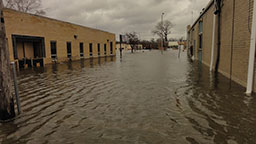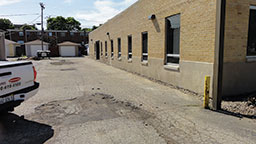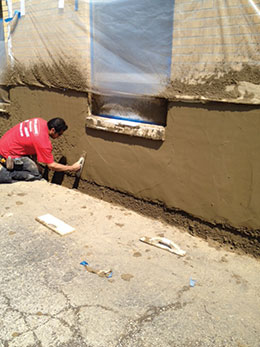Moisture Management
Draining the Rain
Advancements in engineered rainscreen wall systems
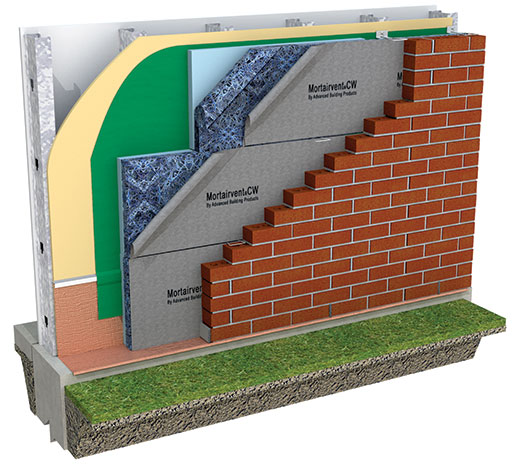 A tremendous amount of innovation has occurred in the construction industry over the years. Yet, the ability to achieve a waterproof wall system still eludes us. If the wall is not designed properly, this moisture will remain trapped. This can cause numerous issues, such as the corrosion of structural reinforcing, rot and mold.
A tremendous amount of innovation has occurred in the construction industry over the years. Yet, the ability to achieve a waterproof wall system still eludes us. If the wall is not designed properly, this moisture will remain trapped. This can cause numerous issues, such as the corrosion of structural reinforcing, rot and mold.
Trapped moisture will decrease the effectiveness of certain insulations and decrease the overall life span of the building. Roughly 90 percent of all wall failures are the result of moisture-related issues. Moisture intrusion is a concern that architects and builders need to strongly consider when designing and building.
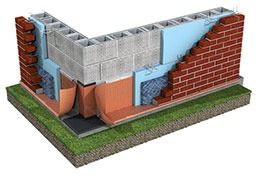 |
|
| Exhibit A |
The cavity wall system is designed to properly “drain the rain.” These systems typically are designed with a backup wall, airspace and outer veneer. Moisture management components such as through-wall flashings, mortar deflections and drainage devices at flashing locations are used to divert moisture that enters the wall back to the outside. Exhibit A is a typical cavity wall detail.
A successful cavity wall requires a few key factors. First, the through-wall flashing specified must last the life of the building. It costs roughly $275 per square foot to replace failed flashing, so the economic value to doing it right the first time is obvious.
Another important aspect to a successful cavity wall is a clear cavity. Without a clear airspace, moisture will not drain effectively. A two-inch cavity is the industry standard for commercial cavity wall construction; however, with new energy codes, a call for increased insulation exists. This is causing wall space concerns.
We are seeing cavity airspaces range anywhere from two inches all the way up to more than four inches. This increased thickness inflates the overall cost of the wall system, which is making the cavity wall system less price competitive, compared to alternative design methods in the market. What if there were a better way?
Engineered rainscreen wall systems have been around for quite some time. However, the difference between a pressure-equalized rainscreen wall and a cavity wall can be confusing. First, we need to modify the terminology slightly. Pressure equalization is a lofty goal and one that is difficult to truly achieve. In reality, the goal is to create a pressure-moderated wall system. These systems are known as ventilated facades or modified rainscreen walls.
Differential air pressures between the inner wall and outside environment will draw moisture into the wall system’s inner structure. A cavity wall system does nothing to prevent this from happening. But a pressure-moderated rainscreen wall system will reduce significantly the differential air pressures that draw moisture into the building. The is due to the air allowed into the wall system, which neutralizes the air pressure behind the cladding to the air pressure outside of the wall system (see Exhibits B and B1).
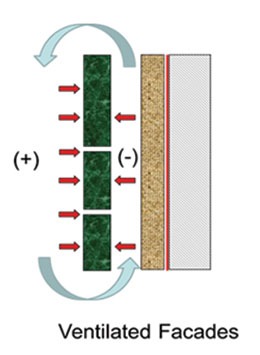 |
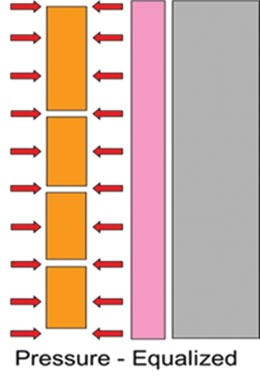 |
| Exhibit B |
Exhibit B1 |
As air is introduced into the cavity, it works its way up the wall and out through vents installed at the top of the wall. The presence of the A/M/V barrier allows the introduced air to circulate in a convective fashion. This convective airflow removes excess moisture vapor, while drying any residual moisture within the cavity at the same time.
A pressure-moderated wall system consists of a backer wall, through-wall flashing, A/M/V barrier, outboard rigid foam insulation, a clear vented airspace with ventilation devices at the top and bottom of walls, and a tough exterior cladding.
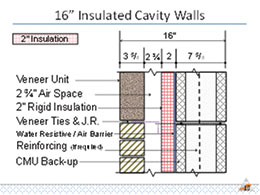 |
|
| Exhibit C |
|
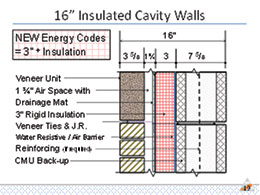 |
|
| Exhibit D |
Since new energy codes are increasing the overall cavity depth, these wider cavities will take longer to neutralize. The wider the air space, the more air needed to enter said airspace for neutralization. By incorporating an all-wall drainage mat in these rainscreen wall applications, the airspace can be reduced greatly without compromising the functionality of the intended airspace.
For example, Exhibit C shows a 16-inch-wide wall system with two-inch rigid outboard insulation and a 2.75-inch airspace. By installing an all-wall drainage mat as seen in Exhibit D, the airspace can be reduced to 1.75 inches, which will neutralize the air pressure quicker.
More important, it also allows the designer to increase the R-value of the same 16-inch-wide wall system. If increased insulation is not desired, the overall wall system can be reduced greatly and still drain and ventilate as intended. Using an all-wall drainage mat also will reduce the cost of the overall wall system.
For example, a narrower air space will reduce the width of the through-wall flashing needed. This narrower cavity also will reduce the size of the wall reinforcing needed. The concrete costs will be reduced as well. As previously mentioned, we know the industry standard for a cavity width is two inches; however, code minimum is one inch. By building with an all-wall drainage mat, this cavity width can be cut in half, and still drain and ventilate as effectively as a wider airspace.
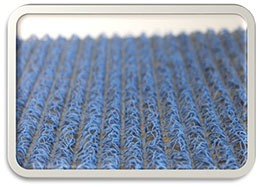 |
The December 2013 issue of “ASK IMI” included research on all-wall drainage mats. What was found was that an air space with a 3/8-inch continuous drainage mat can be just as effective as a two-inch air space, where increased insulation and a minimum wall thickness are design parameters. All-wall drainage mats typically are made from either a corrugated sheet, dimpled mat, or a random entangled net material. These drainage mats are favorable for these wall applications for a number of reasons.
- Mold and mildew resistant
- Allow multi-directional drainage and ventilation
- Resistant to most known chemicals
- Manufactured from recycled materials
- Class A fire rating (ASTM E84)
- Compatible with freeze-thaw conditions
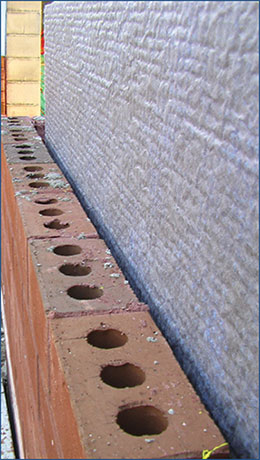 |
|
| Exhibit G |
|
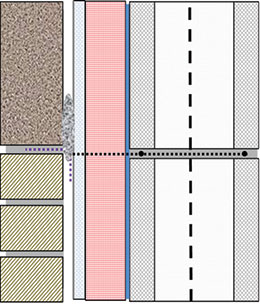 |
|
| Exhibit F |
When specifying an engineered rainscreen material for masonry applications, it is important that the drainage mat have a filter fabric bonded on one side. This filter fabric acts as a mortar deflection. Moisture can get through, but the mortar will not. The drainage mat keeps a uniform airspace for proper ventilation and drainage. Without a filter fabric, the scratch coat will clog the drainage medium, reducing the wall’s ability to drain and ventilate.
Drainage mats should not be the same width as the air space as shown in Exhibit G. Often, a one-inch airspace is a nominal one inch. Enough space needs to exist between the back of the brick and the drainage mat for the mason to put his fingers, making it easier to lay the brick or stone. Most excess mortar in the bed joints will be forced out of the wall, rather than fall within the cavity. As you can see in Exhibit F, even if there is a slight mortar build up, the filter fabric will allow the moisture to drain through and down the wall to its exit point.
In order to prevent mortar bridging due to capillary action, it is recommended that the drainage plane be 3/8-inch or greater. In section 9.27.2.2 of the 2005 NBC of Canada, it is stated clearly that there needs to be “a drained and vented air space not less than 3/8-inch deep behind the cladding, over the full height of the wall.”
We are seeing the importance of all-wall drainage mat technology more in our industry. Organizations such as the Building Enclosure Moisture Management Institute (BEMMI) have worked with stakeholders in the industry to establish minimum requirements for engineered rainscreen materials. BEMMI is now in the final stages of obtaining an ASTM standard for polymeric sheet materials used to provide rainscreen functions.
Other organizations are acknowledging the need for all-wall drainage mats, because these mats are not only beneficial in cavity wall applications. Stucco and manufactured stone applications are seeing the value of a drained cavity created by these all-wall drainage mats as well. The cavity created by these drainage mats gives a cavity wall concept without the cost of a true cavity wall system.
Points of consideration for specifying and using an all-wall drainage mat:
- Rainfall totals and frequency
- Wetting and drying cycles
- Wind and storm conditions
- Freeze-thaw conditions
- Temperature
- Humidity
It is recommended by building professionals to use all-wall drainage mats in geographic locations receiving 20 inches of rainfall or more a year. It is becoming code for areas receiving 60 inches or more of rainfall a year to use all-wall drainage mats.
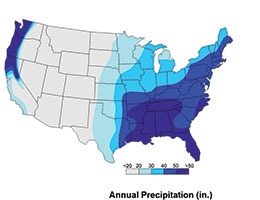 |
Areas that have high wind content are prime candidates for rainscreen drainage mats. For example, a 50-mph wind will exert 6 pounds of pressure per square inch on a wall’s surface. This is enough pressure to force moisture into cracks of any size.
In summary, building with rainscreen technology will allow moisture to drain and ventilate properly by reducing the amount of moisture allowed to linger in a wall system. Building owners will see a significant decline in efflorescence, staining, structural decay, poor indoor air quality and an increase in the life cycle of the building. All-wall drainage mats have proven to be an effective way to improve the life and performance of a building.
Keith Lolley is VP of Advanced Building Products and serves on the board of directors for the Building Enclosure Moisture Management Institute (BEMMI). He can be reached at??klolley@abp-1.com.??For more information, visit??www.advancedbuildingproducts.com??or??www.bemmi.org.
Case Study
|
||||
Citywide Printing is a full-service print shop in Des Plaines, Ill., that specializes in commercial printing projects. The print shop and equipment are located in a business district not far from the Des Plaines River, in a designated flood zone. With almost $1 million of equipment inside the concrete building, Citywide owner Jim Hess looked to a local contractor for a waterproofing solution. “I bought the building three years ago,” says Hess. “I knew it was in the floodplain, but not all that close to the river, and would need to carry FEMA flood insurance. I had heard about Xypex waterproofing from an architect who had specified it for tunnels. It sounded like a perfect solution for my print shop. I contacted Safeguard Basement Waterproofing to get more details.” Tim Denman from Safeguard brought the local Xypex representative, Sandy Bradford-Dice, to the building site to evaluate the waterproofing options. The Citywide Printing building is a 4,600-square-foot brick building. Denman and Bradford-Dice recommended treating the bottom four feet of exterior walls with one-half inch of Xypex Megamix II on the outside. Xypex Megamix II is a thick repair mortar ideal for patching and resurfacing concrete. It can be sprayed on or trowel applied.
Denman’s Team mixed the Xypex Mega Mix II – which was purchased at RKD Construction Supplies – on site and added a dioxide color to match the existing brick. Then they sprayed it on and troweled it to create a light sand finish. The owner also had flood doors installed throughout. Just one year later, the value of Hess’s decision to waterproof was validated. On April 18, 2013, more than five inches of rain fell in just 24 hours on already-saturated areas in the region.?? Several days later, the Des Plaines River crested at 10.92 inches, six feet above flood stage. The overflow spread throughout the area, including into the commercial business district where Citywide Printing is located. The waters in the Citywide Printing area rose to 27 inches high on one side, completely surrounding the buildings. “I would have lost everything if not for the waterproofing,” says Hess. “As bad as the flooding was outside, no water came through my building in the Xypex treated areas.” For more information, visit www.xypex.com. |
